Diver Driver
First Experiences as a Jump Pilot
Page 2 of 2
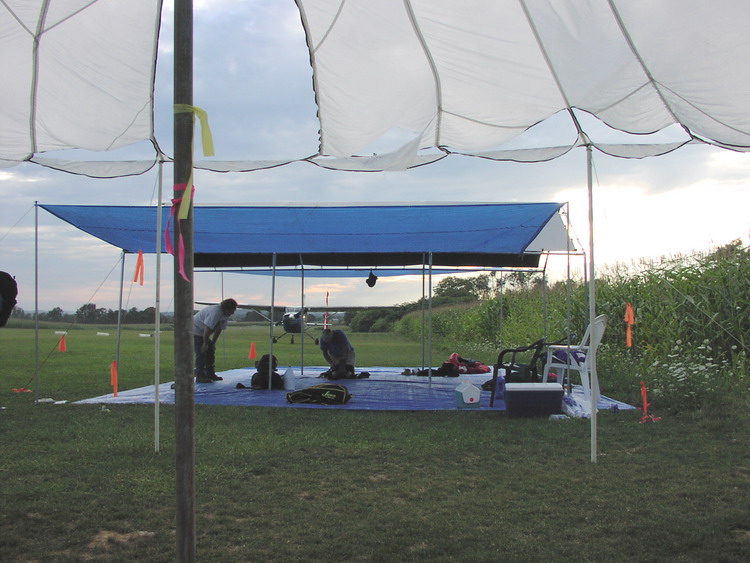
End of a long jump day, Kutztown, PA, Summer 2005
Beep Beep Beep
My eyes open. It's dark. I struggle to turn my head to look over at my alarm clock. It says a bit after 3 AM. Damn. Too early, and only 3 hours since I managed to get to bed. I've awoken in advance of my 4:30 AM rise time because I'm nervous about what lay ahead today -- my first full weekend as a Jump Pilot. I try to go back to bed, and my sheer exhaustion -- the result of a very busy week at work -- fights with my "get up and go" adrenaline as I drift in and out of consciousness.
As it often seems, just as I've managed to get back to sleep I hear that oh-so-refreshing alarm clock sound -- Beep Beep Beep Beep Beep Beep. Damn -- 4:30 already? Where the hell did that hour and a half go? Oh well. I have to get up now. I open my eyes. It's still dark. I reach over, turn off the alarm clock, and fall back into bed for a few moments to contemplate how I arrived at this very point in my life.
Who the hell in their right mind gets up before sunrise? I mean, if God had meant man to get up at oh-dark-thirty he would have made the sun rise at this time. Of course, this is all irrelvant, but crazy thoughts like this are just part of the chaos that exists in the human mind between deep slumber and full consciousness. I have something to do. Someplace to be. My reputation, both as a pilot and a businessman, is at stake here. I can't let anyone down. Like it or not, it's time to get up. Such is the life of a commercial pilot.
Duty Calls
I leave the house at 5:45 and arrive at East Stroudsburg at 7:45, just as Sky's The Limit staff are beginning to arrive. While I'd like to stick around in familiar settings, duty calls me elsewhere, so I preflight the airplane, sign the daily flight log indicating acceptance of the aircraft, and prepare to depart for Kutztown, PA. I have a passing familiarity with the only working navigation gear aboard the airplane -- an antiquated Northstar M1 Loran. Somehow I manage to tell it I want to go direct to N31, but knowing Loran as I do I don't put any faith in its positional accuracy. Reverting to my earliest cross country training, I put my hand on the sectional chart near a VOR and align it parallel to my courseline to get a rough magnetic heading and launch.
Enroute, I find visibility on this hot and humid day is around 5 miles and there's a pesky scattered deck forming around 2500 feet -- right at my minimum comfortable enroute cruising altitude in this area. If I were flying the 172 I'd be on an instrument flight plan cruising at high altitude. Today, however, my pilotage skills get a workout as I struggle to recognize roads, powerlines, small lakes, and even ridgelines north of Allentown, PA. As my direct courseline cuts through the northwestern edge of the Allentown Class C, I call Allentown Approach on the scratchy old radio to get clearance, hoping that Allentown would be able to decipher my noisy transmission. They do. Just barely.
A few miles north of the Kutztown airport, I find a familiar tower north of the field I'd used last year while heading home following an alternator failure in the 172. I knew to look south of the tower to find the airport, and sure enough, there it was. Kutztown has two runways, one north-south asphalt and one east-west grass. Naturally, I chose to go with what I thought as the safe bet -- asphalt. As I turn final, however, I'm reminded that the runway is a washboard. "The flare's bound to be interesting", I think to myself.
After touchdown, I taxi off on the grass runway and see the structures associated with the dropzone for the first time -- a small operation at the approach end of runway 28. As I taxi the full length of the runway, I find the grass well manicured, but I resolve almost immediately to avoid using it for jump operations until I'm comfortable with the airplane. I realize this will undoubtedly add some taxi time to each load, but better safe than sorry. This would be the first of many quick and prudent decisions I'd make as a commercial pilot over the coming months.
Introductions
I pulled the 182 up to the tents, shutdown, and walked over to the manifest office to introduce myself to the dropzone owners. They seemed like nice enough people, but I could tell that they were naturally concerned about my newbie status and their need to fly as many loads this weekend as possible. Apparently the recent and unexpected departure of their previous pilot forced them to reschedule most of last weekend's jumps to this weekend. They told me they had a "very full schedule" and we'd need to "keep it moving". Not exactly words I wanted to hear on my first day. I pointed out my piloting experience as well as the fact that I was working (albeit slowly) toward my A-license, and told them I'd do my best. As I walked back to the airplane to get my bags (this was an overnight gig, after all), I couldn't help but think "what the hell have I gotten myself into?"
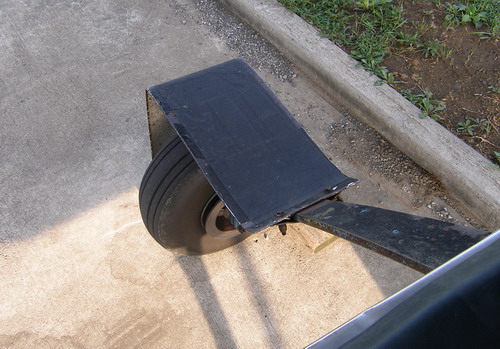 When
I finished that chore, an amiable skydiving instructor named
Chuck appeared to welcome me and offer his support. He told me
that in addition to being one of the tandem masters at the
dropzone, he had about 1200 hours flying jumpers in 182s. It
didn't take me long to recognize Chuck as a wealth of good "real
world" information, so I smiled and asked him for any and all
advice. He was forthcoming with information on fuel management
and weight and balance, and generally reassured me that what I
was about to do was neither dangerous nor abnormal -- provided I
kept up with the airplane. The insights he provided certainly put
me at ease.
When
I finished that chore, an amiable skydiving instructor named
Chuck appeared to welcome me and offer his support. He told me
that in addition to being one of the tandem masters at the
dropzone, he had about 1200 hours flying jumpers in 182s. It
didn't take me long to recognize Chuck as a wealth of good "real
world" information, so I smiled and asked him for any and all
advice. He was forthcoming with information on fuel management
and weight and balance, and generally reassured me that what I
was about to do was neither dangerous nor abnormal -- provided I
kept up with the airplane. The insights he provided certainly put
me at ease.
Fuel Management
When flying the 172, I usually fly long distance with only myself and maybe one other passenger (or a ton of bags). I top off the tanks and launch knowing that the amount of fuel aboard typically exceeds my bladder range. Unless weather goes south at the destination and I'm forced to hold or divert to an alternate, fuel is generally not a concern. And when I fill up, there's no dipping the tanks -- I just fill it up to the collars. In jump operations, however, we need to carry more people than fuel, so jump pilots always fly with less than full fuel -- often between 1/4 and 1/2 tanks -- levels I semi-jokingly refer to as "vapor".
When you start flights with so little fuel on board, fuel management becomes critical. Fuel must be checked and rechecked. In fact, the first day I measured fuel before I filled the tanks (so I knew how many gallons to add to achieve the desired total quantity) as well as afterwards so I could say without a doubt precisely how many gallons I had on board prior to the jump run. The second dip confirmed the amount of fuel I entered and thus the accuracy of the gauge on the fuel truck. Think you can take that for granted? Not when you're playing around with minimum reserves. Once I got to trust the fuel truck gauge and my own math, I eventually eliminated the check after filling the tanks in the interest of brevity, but the process served its purpose.
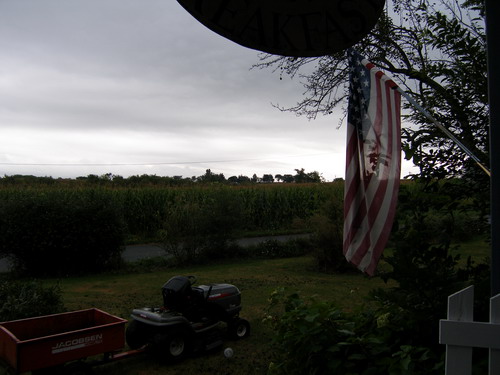 The 182 had two dipsticks. One was a universal fuel
stick calibrated for this particular aircraft, while the other
was a wooden stick with notches sawed into it at fuel levels that
corresponded to the number of loads possible including reserve.
Therefore, every time I dipped the tanks to determine the fuel
quantity, I used both sticks and took both a numerical reading
(which I'd then convert to a number of gallons using the
conversion chart) as well as a reading expressed in terms of the
number of loads. After only a few loads, I learned to associate
one number with another, and this helped confirm that I was
taking readings consistently over time.
The 182 had two dipsticks. One was a universal fuel
stick calibrated for this particular aircraft, while the other
was a wooden stick with notches sawed into it at fuel levels that
corresponded to the number of loads possible including reserve.
Therefore, every time I dipped the tanks to determine the fuel
quantity, I used both sticks and took both a numerical reading
(which I'd then convert to a number of gallons using the
conversion chart) as well as a reading expressed in terms of the
number of loads. After only a few loads, I learned to associate
one number with another, and this helped confirm that I was
taking readings consistently over time.
At the conclusion of two loads to 10K, I typically recorded "2.0" for the universal fuel stick (about 7 gallons) and "0.5J" (half of a jump load) per tank remaining before I was into the minimum reserve (about 3.5 gallons per tank or 7 gallons total). This translated into roughly 14 gallons -- my expected reserve. The average turnaround time for a 182 load to 10K AGL (starting from near sea level) is around 30 minutes. I was told the aircraft would average 14 GPH and consume roughly 7.5 gallons per load (including runup and taxi time). As I found out over the coming months, this turned out to be quite accurate.
Interestingly enough, I eventually discovered the reason I was asked to replace the former pilot on short notice -- he apparently dead-sticked this very airplane into Kutztown. While the precise reason for the engine stoppage was not determined, it was related to fuel. Chuck speculated that the pilot had been flying the airplane for some time and was conscientious about fuel management, but may have unwittingly been the victim of one of the bugaboos of the early 182s -- vapor lock. Apparently, low fuel combined with a high angle of attack (and hence low head pressure at the carburetor) can cause a vapor lock condition in the vicinity of the fuel selector. In this case, the fuel supply is interrupted until the aircraft levels off or pitches down for some period of time. Chuck pointed out that if I were to experience this problem, it would be wise to secure the engine, lest the fuel supply return to the engine during the flare and add to an already challenging landing.
Weight and Balance
The Caravan pilot I flew with during training showed me a suite of completed weight and balance solutions for the 182 he had developed. The solutions covered 2, 3, or 4 jumpers with fuel on board for 1, 2, or 3 loads remaining. The point of doing these ahead of time is simple--there's no time to do a weight and balance between loads. For all practical purposes, you just need to know your airplane and who's on board. For those conscientious pilots out there that just cried foul, consider that this is very much the way the airlines do things....I mean, when was the last time you actually SAW your pilot, much less have him drop by to ask how much you weigh?
 A brief review of these procedures
revealed that assuming a nominal 200 lb jumper (175lb of meat
plus 25 lbs of parachute equipment), it would be quite possible
to load the 182 over gross weight in spite of having the seats
removed and the interior effectively stripped. In fact, with fuel
for two loads on board, the maximum number of jumpers I'd could
carry would be three unless two of the jumpers were much lighter
than our average. Fortunately, as I would later find out, most of
the folks that flew at this dropzone were younger and hadn't
packed on the pounds yet, so I was often asked to fly four
jumpers and the weight worked out.
A brief review of these procedures
revealed that assuming a nominal 200 lb jumper (175lb of meat
plus 25 lbs of parachute equipment), it would be quite possible
to load the 182 over gross weight in spite of having the seats
removed and the interior effectively stripped. In fact, with fuel
for two loads on board, the maximum number of jumpers I'd could
carry would be three unless two of the jumpers were much lighter
than our average. Fortunately, as I would later find out, most of
the folks that flew at this dropzone were younger and hadn't
packed on the pounds yet, so I was often asked to fly four
jumpers and the weight worked out.
As far as CG is concerned, I found that the 182 would load consistently toward or on the forward CG limit...which is a bit counterintuitive when you consider that at least one of the jumpers is positioned in the far rear of the aircraft near the tail bulkhead. On a normal 182, that position is normally reserved for baggage. That's a relatively large amount of weight far aft of the datum, so you'd tend to think that loading too far aft would be the problem. Simply not so.
Naturally, when it came time to do my first load at Kutztown, I asked the DZOs to manifest only three jumpers. I figured that if I had a problem with the aircraft, this load would be it, so I played it conservative and took off on the asphalt runway for predictable acceleration (and stopping power if required for an abort). Fortunately, the load went off without a hitch, so when two tandems (two hot young women, if you want to know the truth) were manifested for load #2, I took them up with the confidence that only comes from experience.
Clouds (a.k.a "Industrial Haze")
There's a running joke within the skydiving community that clouds aren't really clouds -- they're "industrial haze". Well, to a skydiver that may be true, but to a jump pilot a cloud by any other name is still an obscuring phenomenon. And VFR pilots are required to fly within VFR minimums and cloud clearances. To review, below 10000' MSL, that means 500 feet below, 1000 feet above, 2000 feet horizontally, and 3 miles visbility in controlled airspace (which is pretty much everywhere above 700 AGL here). And, if you were wondering, not only can jump pilots not fly in clouds, Part 105 dictates that pilots cannot release jumpers even if they're flying in good clear weather at 10000 feet if doing so would allow or force them to fall through clouds at a lower altitude to reach the dropzone.
That's the theory, anyway. Now, the reality check. Do pilots release jumpers over clouds? Yes. How many do it Intentionally? Perhaps a few. After all, no one gets paid if the jumpers land with the airplane. The greatest abuses seem to take place at the large dropzones that fly large aircraft and at which a bulk of the jumpers are experienced. Fortunately, I had absolutely no pressure to conduct such operations at Kutztown because the majority of the work there was student activity, and we were all trying to set a good example for the students. I found it kept everyone honest, myself included.
The first weekend I flew in Kutztown, the weather was extremely hot and humid, but at least the clouds were few and far between and the visibility rose to a respectable 8 miles by late morning. The relatively good weather allowed me to learn the local area landmarks, hone my spotting technique, and keep the airport in sight at all times while I learned how to get into the groove of jump operations in general. In fact, I flew more loads (a total of 19) during my first weekend as any weekend to date, as virtually every weekend that followed exposed me to jump operations in less than optimal weather conditions that impacted our ability to fly loads. While the first weekend was grueling simply from a workload perspective, I found the questionable weather days far more stressful. They were also, strangely enough, the most rewarding because I knew I'd done the best, safest job possible given the conditions.
One particularly weather-challenged weekend I dodged low clouds and rain showers to arrive at Kutztown on time only to pull off a mere three loads before we called it quits for the day (and, as I would find out, the remainder of the weekend). Did I sit around and mope? No way. As they say "when dealt lemons, make lemonade", so I hung out with the dropzone owners, chatted incessantly about skydiving, watched lots of skydiving videos, and got a personal tour of a master rigger's workshop where i learned more about parachuting equipment and packing than any skydiving instructor had taught me to this point. It was like attending a free skydiving camp!
I tried flying home later Sunday but had to return to Kutztown when weather enroute turned out to be worse than the METARs in the area indicated. I was forced to leave the aircraft in Kutztown and impose on my long-time friend and jump partner Todd to pick me up, but I drove out of Kutztown comfortable in the knowledge that I hadn't let the pressures of commercial flying cloud (no pun) my judgement. Needless to say, I returned the following weekend to far better weather and managed to fly another 18 loads.
Emergency Procedures
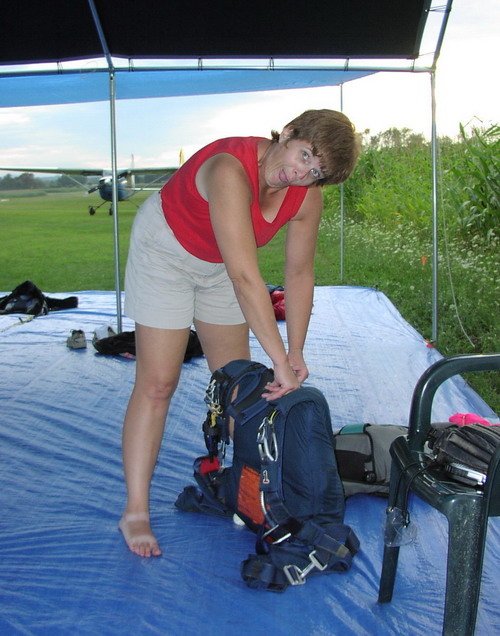 While jump pilots don't have to be skydivers, it does help
reduce the amount of time spent in initial training and gives the
pilot the eyes of a skydiver. Because skydivers wear equipment
that can malfunction in the airplane, it helps if a jump pilot
can spot a condition that requires immediate action. Take, for
instance, the last load of my first weekend at Kutztown. I had
four jumpers aboard -- an Accelerated FreeFall (AFF) student with
two jumpmasters (the dropzone owners, coincidentally) along with
one experienced jumper.
While jump pilots don't have to be skydivers, it does help
reduce the amount of time spent in initial training and gives the
pilot the eyes of a skydiver. Because skydivers wear equipment
that can malfunction in the airplane, it helps if a jump pilot
can spot a condition that requires immediate action. Take, for
instance, the last load of my first weekend at Kutztown. I had
four jumpers aboard -- an Accelerated FreeFall (AFF) student with
two jumpmasters (the dropzone owners, coincidentally) along with
one experienced jumper.
First, some background. The 182 has a manual flap extension handle that functions like that on modern Piper aircraft. I took off from the grass runway with flaps at the 10 degree position, which put the handle at up at about a 30 degree angle. The student jumper was sitting where the passenger seat would be, with his back to the panel and his butt in the passenger's foot well. To deploy a sport parachute, the jumper pulls a collapsed miniature round canopy called a pilot chute out of a pocket affixed to the bottom of the parachute container. The pilot chute is attached to the main canopy release pin via a nylon bridle. When properly packed, only the handle of the pilot chute is visible on the right side of the jumper (in this case, facing the flap handle). Some pilot chute handles are made of a piece of 3/4" PVC tubing and are orange in color, while others are soft and round and resemble a hackey sack. In this case, the student's pilot chute handle was of the hackey-type.
Anyway, back to the jump run. After takeoff I slowly lowered the flap handle to retract the flaps as I watched airspeed to ensure I maintained control at low altitude. At 1000 feet AGL I proceeded to complete my after takeoff flow, which started at the fuel selector and worked up toward the flap handle. When I looked more closely at the flap handle, I found the student's pilot chute handle snugly wedged underneath the flap handle near its hinge. Attempts to lift the flap handle slightly and push the pilot chute handle clear failed, so I got one of the jumpmasters involved. They thanked me for pointing it out and told me that they'd fix the problem when the student turned around in preparation for exit (with the door still closed) at around 9000 feet. And, in fact, that's what happened. No muss no fuss.
But what might have happened if the jumper didn't have anyone looking out for him (jumpmaster, or other experienced skydiver)? If the jumper got up, the pilot chute would have been pulled out of the container. While repacking a pilot chute in a crampt 182 would have been a challenge, that wasn't the real threat. Had the deployed pilot chute gone unnoticed and exited the aircraft when the jump door opened, it would have deployed the jumper's parachute and forcefully pulled the jumper out of the aircraft, very likely injuring him -- perhaps fatally. What's worse, the parachute could wrap itself around the tail of the aircraft and promptly rip it from the fuselage, rendering the aircraft unflyable. In that case, the pilot would be going for a skydive too.
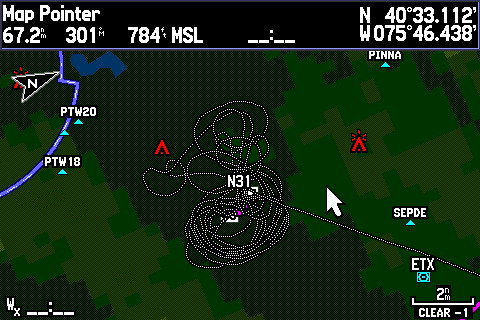 Now, think it's easy enough to jump out of the aircraft and
pull the ripcord? Let me tell you -- under the best, most
controlled conditions (like a normal jump run) it's hard enough
for the first timers to commit to the task. Then assuming the
canopy opens successfully without any malfunctions there's the
small problem of knowing how to steer the canopy to avoid
obstacles and how to do a Parachute Landing Fall (PLF) to
touchdown following a descent that -- at best -- exceeds 13 feet
per second. That not sound like much? Imagine jumping from a 15
foot ladder! If you're not prepared for it, you will break
something. And for a pilot who's never experienced freefall or
landing a parachute, learning all of that on the fly (no pun) is
a tall order.
Now, think it's easy enough to jump out of the aircraft and
pull the ripcord? Let me tell you -- under the best, most
controlled conditions (like a normal jump run) it's hard enough
for the first timers to commit to the task. Then assuming the
canopy opens successfully without any malfunctions there's the
small problem of knowing how to steer the canopy to avoid
obstacles and how to do a Parachute Landing Fall (PLF) to
touchdown following a descent that -- at best -- exceeds 13 feet
per second. That not sound like much? Imagine jumping from a 15
foot ladder! If you're not prepared for it, you will break
something. And for a pilot who's never experienced freefall or
landing a parachute, learning all of that on the fly (no pun) is
a tall order.
GPS is a Spotter's Dream
The first several weekends I flew jump runs the "old school" way, in other words, by visual reference. I struggled to see the airport through the cloud layers. One time the visibility was so bad I could barely see the airport, so I had to use other prominent landmarks to orient myself. As one landmark would find its way behind some clouds, I'd look for the next, and around the airport I went. Of course, I could have used a GPS, but I was told that it would be best if I did NOT use GPS until I knew how to spot. I thought that was a bit crazy, but since I didn't own a portable GPS, the point was moot. I'd be doing it the "hard way" for the foreseeable future.
The idea in spotting is to figure out where the winds are coming from at all altitudes from the surface to the release altitude, take the average direction with emphasis on the lower altitudes (since the jumpers are under canopy below 5000 feet and are more affected by winds), fly a jump run directly into the wind, and release the jumpers precisely over a point that will allow them to get back to the field.
Spotting visually is difficult simply because, even in great weather, you can't see directly below the airplane, so you have to pick references on the left side of the aircraft that you know will put the aircraft on the desired flight path. It takes some experience spotting loads to determine if you're truly flying directly over the desired flightpath. The advent of GPS has, fortunately, made much of this neck craning unnecessary, while it's added some very handy features. About two months into my stint as a jump pilot I managed to get my hands on a Garmin 396. The uplinked weather was the thing that sold it for me, but it was the low-tech tracking technology that I drooled over when it came to doing jump runs. The 396 displays the track history of the aircraft, so at sufficiently low range settings (typically 0.8 to 1.2 miles), it's possible to see the track and retrace the last track. And I mean the EXACT same track. This came in very handy when the jumpers would tell me "hey, great run...do that on the next load".
As part of the process of learning how to spot, I'd listen to the jumpers during flight. Once the door would pop open, they'd give me directions "10 right", "20 left", etc. When the heading changes were minor or when they didn't say anything at all, I knew the run was on center. And after I released the jumpers and got back on the ground, I'd ask the jumpers how the run was so I could improve it next time. While occasional heading changes were part of the normal course of spotting visually, the jumpers were pleasantly quiet (at least with respect to heading changes!), when spotting via GPS. No surprise, really. When everyone agreed that the spot was over the water tower, I'd be able to put the airplane EXACTLY over the water tower (well, within a couple hundred feet of it, anyway).
Now, you might be thinking "so, if I'm going to be a jump pilot, I *need* a GPS". Not really. While it's hard to imagine a world before GPS, pilots have been spotting visually since the beginning of time, and today the best pilots can spot equally well by visual reference as they can with GPS. Because I took the time to learn how to spot visually, GPS is now a convenience -- admittedly one hell of an advantage that allows me to fly more precisely (and with uplinked weather, far more safely), but it's a convenience nonetheless.
Reflections
While I was only supposed to work a few weekends a month, several prospective pilots who were to supplement my schedule fell through, so I wound up working every weekend for several months, non-stop. That took a lot out of me, but as I reflect on the time I feel what I got out of the deal far outweighed the obvious workload and stress of working 7 days a week.
Something happened that I didn't exactly expect. I really grew to enjoy seeing the DZ owners, instructors, and experienced jumpers I met in Kutztown, learning what their vast experience could teach me both as a pilot and a skydiver. I also learned to balance the rigors and professional responsibilities of the job with the lighthearted aspects of the sport. I remember getting into the spirit of things as tandems (newbies) were boarding the aircraft by saying stuff like "Hey Chuck, guess what, I got up to Chapter 3 on the airplane's operating manual last night. I think I know how to land now!" All in good fun. And that's what skydiving in all its forms really is: pure, unadulterated fun!



